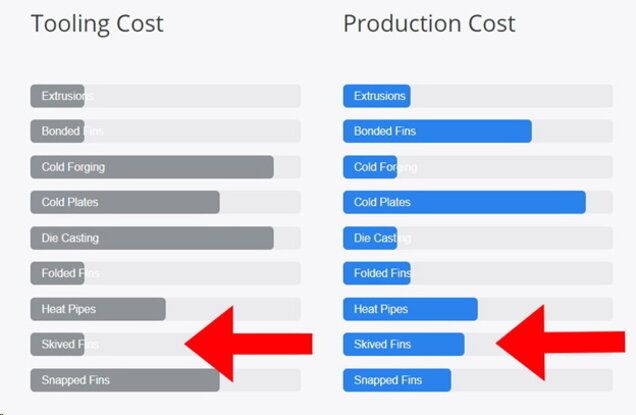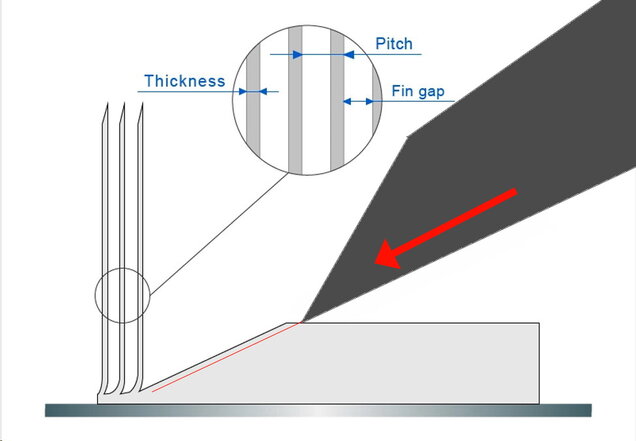A Skived Heatsink offers excellent thermal properties compared with other manufacturing methods as it offers a thin finned heatsink, with a dense population of uniformly shaped and distributed fins. As a Skived Heatsink is made from a single block of material such as copper or aluminum additional interface resistance that is common in other heatsink manufacturing processes such as stamped or folded fins that have a thermal resistance from the use of solder to attached the fins. This combination of high aspect ratio thin fins with no thermal resistance interface, produces optimum cooling performance in high airflow applications.

Skived Heat Sinks production cost compared to other type of heat sinks production
Skived Heat Sink Benefits/Features
- Skived heatsink can be an alternative to extruded heat sink when looking for a fin density which can NOT be achieved by extrusion technology.
- Skived heatsink fabrication does not need expensive tooling which provides greater design flexibility. Instead, each fin is cut separately using the same tool which allows for lower tooling costs.
- Skiving heat sink can be made of copper and aluminum, enables solid copper solutions.The skiving process is a good thermal solution for high power cooling.
- Skived heat sink leading the heat innovation high density ,high thermal performance, high aspect ratio, excellent performance.
- Skived heat sink without interface joint between the fins and base, improved thermal performance than traditional heat sink.
- Integrated manufacturing, no welding and mold opening;
- The thickness and spacing of fin can be made thinner and denser;
- The thermal conductivity is superior to the traditional extrusion and bonded fin process.
- High fin densities
- Perfect conductivity between base & fins
- Great forced airflow solution
- Low tooling cost
- A skived heat sink can be double sided like for flexible core heat exchanger tubes

Thermal conductivity comparison of aluminium heat sinks
die-cast - extruded - skived - cold formed

Benefits of a Skived fin Heat Sink
Performance of different types of heat sinks
Aluminium extruded and die cast heat sinks dominate the industry. As devises that require cooling becoming smaller and heat generation increases, companies are forced to look for a more efficient cooling solutions. One of them is SKIVED FIN heat sinks.
Comparing Skived fin heat sink design to bonded fins type assembly, Skived Fins will outperform by large margin due to bonded assembly. Thermal transfer is somewhat reduced by the bonding agent added thermal resistance. There are five common techniques that are used to manufacture heat sinks out of one piece:
- Die Casting
- Machining
- Extrusion
- Forging
- Skiving Fins
Let’s discuss performance of each of those types of heat sinks:
Thermal Conductivity
Diecasting is a method for manufacturing complex shapes in high volumes and low cost. Initial tooling cost outlay is high, but the parts cost during the production run is relatively low. Drawback is porous structure as the molten aluminium alloy cools in the die-set it expands creating voids. The porous structure weakens the part and adds to thermal resistance to the heat sink.
Extruded aluminium alloy heat sinks are most cost effective way for manufacturing linear shapes. The drawback is the limitation in the freedom in design, but this method requires low cost tooling. During the extrusion, alloy is heated below melting point and force-feed thru the forming die-set. However the grain structure cannot be controlled evenly and shape of the heatsink cannot be optimized completely thus somewhat reduce thermal performance.
Machined heat sinks: This way of producing is due to high CNC machining costs of machined heat sinks, economically feasible only for prototyping and special low volume and high cost products. Cost of production is limiting this heat sinks to prototype production.
Forging is the most effective method to produce complex shapes in high quantity and also offers interesting thermal advantages due to processing alloys at room temperature. Due to the nature of the forging process, part is formed at high pressure and low temperature, process that allow better control of the grain structure. Making heat sinks stronger and better conductors of heat. See here for more info on this subject.
Skiving fins is the latest technology, which is very promissing and grows exponential due to the many benefits: heat sink is formed out of one block with the highest cooling capacity per weight of material.
Skived Fin Heat Sinks offer highly optimized cooling as they allow for higher fin densities than what is manufacturable using extrusion methodologies, but do not have an interface joint that restricts heat flow like bonded or brazed fin heat sinks. Unlike bonded or brazed heat sinks, Skived Fin Heat Sinks are constructed from a single piece of material and offer reduced thermal resistance since there is no joint between a base and fins. These heat sinks are manufactured by precisely slicing the top of the base, called skiving, folding it back to where it is perpendicular to the base, and repeating at regular intervals to create fins.
The skiving process enables high fin density and thin fin heat sink geometries for optimal thermal performance. By packing as much fin surface area into a given volume, skived fin heat sinks have greater heat transfer than other single piece construction heat sinks such as extruded aluminum heat sinks. Compared to extruded aluminum, skived fin heat sink fabrication does not rely on expensive tooling, providing greater design flexibility and faster prototyping. Instead, each fin is cut separately using the same tool which allows for lower tooling costs.
Skived heat sinks can be constructed of aluminum or copper allowing for full, one-piece copper solutions for high performance cooling.
The Skived fin process produces heat sink with 18% better thermal conductivity over extruded and 72% over die-cast part. Note that in this test average samples been tested. Best examples of each heat sink likely to produce better results somewhat dampening large outperformance by forged part.
Heatsink Surface Area
Increased surface area of the heat sink will yield lower thermal resistance and better component cooling, but only if boundary layer is not formed and fins close proximity do not prohibit flow of air. When designing extruded part, fins must be tapered so that the aluminium alloy will pass through the tool without breaking it. The number of fins in an extrusion limited by strength of the die set and the size of the extrusion. These restrictions have negative impact on the surface area.
Skived fins require no taper for extraction from the tool, allowing for more fins per given heat sink size. The Skived fin heat sink increases the surface area by 21% without increasing the size. The result is improved thermal performance.
Reduced Cost
Depending on design, skived fin heat sink process can simplify manufacturing process. In cases when secondary operation required when working with extruded or die-cast heat sinks in skiving fins process this can be part of a single operation. That can greatly influence cost of the finished product. As the tooling cost is ZERO, this influence drastic the production cost!
Conclusion
Skived fin heat sinks together with Forged heat sinks offer many advantages over machined, die cast and extruded processes. The improved thermal performance due to aluminium grain structure coupled with the increased surface area without increasing the size of the heat sink and low process cost are main advantages.
Skiving fins is also a very effective method for forming copper heat sink. Copper is difficult to extrude because it must be heated to high temperatures to soften the metal, making it challenging. Skiving is a cold process, and copper heat sinks can be formed with minimal waste.

